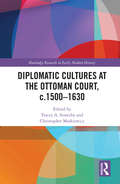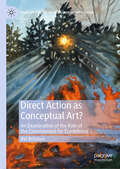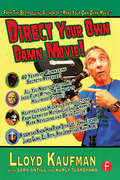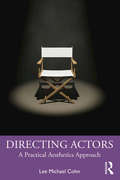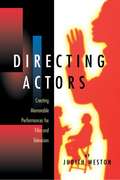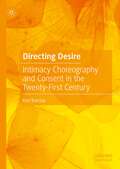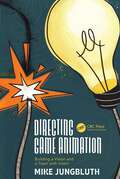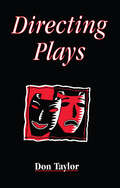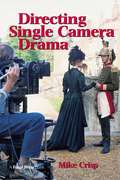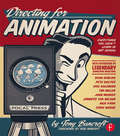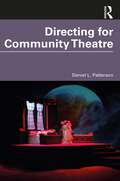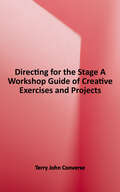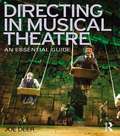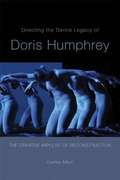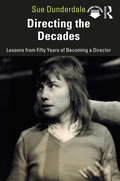- Table View
- List View
Diplomatic Cultures at the Ottoman Court, c.1500–1630 (Routledge Research in Early Modern History)
by Tracey A. Sowerby; Christopher MarkiewiczIn the sixteenth century, the Ottoman court in Constantinople emerged as the axial centre of early modern diplomacy in Eurasia. Diplomatic Cultures at the Ottoman Court, c.1500-1630 takes a unique approach to diplomatic relations by focusing on how diplomacy was conducted and diplomatic cultures forged at a single court: the Sublime Porte. It unites studies from the perspectives of European and non-European diplomats with analyses from the perspective of Ottoman officials involved in diplomatic practices. It focuses on a formative period for diplomatic procedure and Ottoman imperial culture by examining the introduction of resident embassies on the one hand, and on the other, changes in Ottoman policy and protocol that resulted from the territorial expansion and cultural transformations of the empire in the sixteenth century. The chapters in this volume approach the practices and processes of diplomacy at the Ottoman court with special attention to ceremonial protocol, diplomatic sociability, gift-giving, cultural exchange, information gathering, and the role of para-diplomatic actors.
Direct Action as Conceptual Art?: An Examination of the Role of the Communiqué for Ecodefense (Palgrave Studies in Crime, Media and Culture)
by Avi BrismanThis book offers an avenue for understanding the parameters, scope, meanings, and impacts of environmental protest. Focusing on ecodefense, it explores the significance of the communiqué (the written explanation of the reasons for an act of ecodefense), comparing the communiqué to written texts in Conceptual art. It presents and seeks to evaluate the following analogy: act of ecodefense : communiqué :: work of conceptual art : written declaration/statement. By considering the communiqué in this light, this book helps us better comprehend the rationales for “radical environmentalism” undertaken for the purposes of reducing environmental harms, natural resource exploitation, and animal abuse.
Direct Your Own Damn Movie! (Your Own Damn Film School {{series}} Ser.)
by Lloyd KaufmanFilm is a visual medium, the work of Eric Rohmer and Kevin Smith notwithstanding. It is important for a director and cinemtographer to use their VISUAL EYES in order to VISUALIZE how to make their movie most effective. Also, there is the messy business of actors. Generally, movies have them, and directors have to deal with them. This guide will illuminate these two main jobs of the director: directing the camera and directing the actor, while showing how these two jobs manifest themselves during practical filmmaking -- whether it be, 'Which shots can I lose and still tell my story since we're running out of time', or 'How do I get two actors who hate each other to perform a passionate sex scene',' all will be revealed.
Direct3D Rendering Cookbook
by Justin StenningThis is a practical cookbook that dives into the various methods of programming graphics with a focus on games. It is a perfect package of all the innovative and up-to-date 3D rendering techniques supported by numerous illustrations, strong sample code, and concise explanations. Direct3D Rendering Cookbook is for C# .NET developers who want to learn the advanced rendering techniques made possible with DirectX 11.2. It is expected that the reader has at least a cursory knowledge of graphics programming, and although some knowledge of Direct3D 10+ is helpful, it is not necessary. An understanding of vector and matrix algebra is required.
DirectX 11.1 Game Programming
by Pooya EimandarWritten in step-by-step tutorial format, we will explore the creation of 3D applications and games through the development of a Windows 8 metro style game.DirectX 11.1 Game Programming Written for developers with knowledge of C++ essentails and 3D mathematics who would want to create metro style game on the Windows 8 platform.DirectX 11.1 Game Programming explores Direct3D 11.1 and Microsoft C++ component extensions along with introducing C++ accelerated massive parallelism.
Directed by James Burrows: Five Decades of Stories from the Legendary Director of Taxi, Cheers, Frasier, Friends, Will & Grace, and More
by James Burrows&“Being directed by the Jimmy Burrows, while on Friends, was like hitting the jackpot. I&’m delighted that everyone can now share in his incredible insight with this book.&”—JENNIFER ANISTONFrom the director of The Mary Tyler Moore Show, Taxi, Cheers, Frasier, Friends, and Will & Grace comes an insightful and nostalgic memoir that offers a bounty of behind-the-scenes moments from our favorite shows, peeling away the layers behind how a successful sitcom comes together—and stays that way.Legendary sitcom director James Burrows has spent five decades making America laugh. Here readers will find never-revealed stories behind the casting of the dozens of great sitcoms he directed, as well as details as to how these memorable shows were created, how they got on the air, and how the cast and crew continued to develop and grow. Burrows also examines his own challenges, career victories, and defeats, and provides advice for aspiring directors, writers, and actors. All this from the man who helped launch the careers of Ted Danson, Kelsey Grammer, Woody Harrelson, Jennifer Aniston, Debra Messing, and Melissa McCarthy, to name a few. Burrows talks fondly about the inspiration he found during his childhood and young adult years, including his father, legendary playwright and Broadway director Abe Burrows. From there he goes on to explain his rigorous work ethic, forged in his early years in theater, where he did everything from stage managing to building sets to, finally, directing. Transitioning to television, Burrows locked into a coveted job with The Mary Tyler Moore Show, where he first observed and then started to apply his craft. Directing most of the episodes of Taxi came next, where he worked closely with writers/producers Glen and Les Charles. The three formed a remarkable creative partnership that helped Burrows achieve his much sought-after goal of ownership and agency over a project, which came with the creating and directing of the seminal and beloved hit Cheers. Burrows has directed more than seventy-five pilots that have gone to series and over a thousand episodes, more than any other director in history.Directed by James Burrows is a heart-and-soul master class in sitcom, revealing what it truly takes to get a laugh.
Directed by Yasujiro Ozu
by Shiguéhiko HasumiFirst published in 1983, Shiguéhiko Hasumi's Directed by Yasujirō Ozu has become one of the most influential books on cinema written in Japanese. This pioneering translation brings Hasumi's landmark work to an English-speaking public for the first time, inviting a new readership to engage with this astutely observed, deeply moving meditation on the oeuvre of one of the giants of world cinema. Complemented by a critical introduction from acclaimed film scholar Aaron Gerow and rendered fluidly in Ryan Cook's agile translation, this volume will grace the shelves of cinephiles for many years to come.
Directing Actors: A Practical Aesthetics Approach
by Lee Michael CohnDirecting Actors: A Practical Aesthetics Approach is the first book to apply the Practical Aesthetics acting technique to the craft of directing. Lee Cohn lays out a step-by-step, no-nonsense methodology for the director that includes a deep dive into the mechanics of storytelling, the rehearsal process, working with writers, and the practical realities of the director’s job. Featuring end-of-chapter exercises, this book provides a clear and effective means of breaking down a script in order to tell a story with clarity, simplicity, and dramatic force and gives directors a clear working vocabulary that will allow effective communication with actors. The techniques in this book are applicable to any theatrical style and any media platform in which a director might work. Written in an accessible, conversational style, this book strips the process of directing down to its most essential components to explain how to become an "actor’s director." A must-read for students in directing courses and professional directors working with actors who prescribe to the Practical Aesthetics technique, as well as anyone interested in the process of working with actors, Directing Actors will help directors to get the very best their actors are capable of while approaching the work with a joyful, open spirit.
Directing Actors: Creating Memorable Performances for Film and Television
by Judith WestonInternationally-renowned directing coach Weston demonstrates what constitutes a good performance, what actors want from a director, what directors do wrong, script analysis and preparation, how actors work, and shares insights into the director/actor relationship.
Directing Animation
by David B. LevyBoth experienced and aspiring animation professionals will find Directing Animation a comprehensive and entertaining guide to understanding the director's creative role in managing the entire animation process. An animation director doesn't simply direct animation. He or she directs people who animate and must be equally able to relate to the crew, producers, writers, creators, and clients. Readers will learn how to: -- direct commercials, TV series, feature films, and Web features and series -- land their first big directorial break -- create realistic schedules and pipelines -- assemble the best crew for any job -- motivate animators and crew members -- give constructive feedback and notes -- maintain good relationships with producers, creators, writers, and network executives. In addition to over eighty photographs and illustrations, Directing Animation includes insider tips and firsthand experience from animators, directors, and producers, revealing the best ways to manage the production process while creating a workplace that is both efficient and fun.
Directing Animation
by David B. LevyBoth experienced and aspiring animation professionals will find Directing Animation a comprehensive and entertaining guide to understanding the director's creative role in managing the entire animation process. An animation director doesn't simply direct animation. He or she directs people who animate and must be equally able to relate to the crew, producers, writers, creators, and clients. Readers will learn how to: -- direct commercials, TV series, feature films, and Web features and series -- land their first big directorial break -- create realistic schedules and pipelines -- assemble the best crew for any job -- motivate animators and crew members -- give constructive feedback and notes -- maintain good relationships with producers, creators, writers, and network executives. In addition to over eighty photographs and illustrations, Directing Animation includes insider tips and firsthand experience from animators, directors, and producers, revealing the best ways to manage the production process while creating a workplace that is both efficient and fun.
Directing Desire: Intimacy Choreography and Consent in the Twenty-First Century
by Kari BarclayDirecting Desire explores the rise of consent-based and trauma-informed approaches to staging sexually and sensually charged scenes for theater in the contemporary U.S., known as intimacy choreography. From 2015 to 2020, intimacy choreography transformed from a grassroots movement in experimental and regional theaters into a best practice accepted in Hollywood and on Broadway. Today, intimacy choreographers have become a veritable "intimacy industry" in the cultural sphere, sparking attention from Rolling Stone to The New York Times to the sketch comedy series Saturday Night Live. This book analyzes the forces that have led to intimacy choreography’s meteoric rise and asks what implications the field has for theater practice more broadly. Building a theoretical framework for intimacy directing, Directing Desire also strives to reorient the conversation in the field so that artists understand not only best practices in consent but also intersectional frameworks that expand and rework consent.
Directing Game Animation: Building a Vision and a Team with Intent
by Mike JungbluthThe best character animation has a strong creative intent, driving a compelling performance. With the addition of interactivity, game animation adds complexity to the craft of how best to balance art, design and technology to realize a character’s performance. As a director, you are responsible for not only defining a vision for how those should balance but also being a leader, mentor and advocate for your team. But in a field of rapid iteration of ideas and techniques, that strong creative intent can be easily lost or sacrificed if not properly fostered and defined.Directing Game Animation: Building a Vision and a Team with Intent breaks down the process of creating an intentional animation vision that can be both unique and flexible. From defining the high-level experience to breaking down tech needs, projecting a team size and empowering everyone to work together, this book will help you to wrap your mind around a project’s animation needs.Animation, like every part of a game, cannot succeed—let alone function—in a vacuum. This book looks to foster a discussion around the process, needs and benefits of an empowered animation team and its vision as a universal benefit for the entire industry.This book is a guide to answer some of the most common questions people encounter when engaging with the overlap between creative and project leadership. What is your role? Learn how to establish expectations and needs specific to the project and team. How do you establish a vision? Learn how to better define and communicate creative topics such as a cohesive character performance and animation style. How do you build a team? Learn how to establish early on the team structure, skills and workflows needed to deliver on the needs of the project. How do you balance creative and production needs? Learn how to define quality, reviews and approvals in a way that empowers creativity and decision-making.
Directing Plays (Stage And Costume Ser.)
by Don TaylorDirecting Plays explores both the theory and practice of directing plays, with particular emphasis on textual interpretation. Don Taylor guides the student through the complex process of choosing a play, the working partnership of director, playwright and designer, the delicate matter of casting a play, the rehearsal process and everything which needs to happen before the production is up and running.
Directing Single Camera Drama
by Mike CrispDirecting drama for the single camera is like no other form of Filmmaking, or any other medium involving actors. Experience in documentary or theatre may provide useful clues, but the techniques for drama film directors, although not basically complicated, are unique. Experienced directors in other spheres of directing will find this book invaluable if they wish to move into single camera drama, as will students setting out on their careers. Directing Single Camera Drama is a synthesis of the skills required to bring drama to the screen. Directing drama for the single camera is like no other form of Filmmaking, or any other medium involving actors. Experience in documentary or theatre may provide useful clues, but the techniques for drama film directors, although not basically complicated, are unique. Experienced directors in other spheres of directing will find this book invaluable if they wish to move into single camera drama, as will students setting out on their careers. Directing Single Camera Drama is a synthesis of the skills required to bring drama to the screen.A unique feature of the book is the inclusion of ten short film drama scripts which need only half a day's rehearsal and one short day's filming. Each have their various technical demands, and they are arranged in ascending order of dramatic and creative difficulty. They can be photocopied and used for non-broadcast training drama exercises. Mike Crisp worked as Production Manager, and later Director, on many classic BBC TV series, such as Fawlty Towers, Porridge and Steptoe and Son. He was, for 10 years, a senior producer with the BBC's TV Training Department. He is the author of The Practical Director now in its second edition and also published by Focal Press.Reviews:'Directors in other spheres of directing who wish to move into single camera drama will find this book invaluable, as will students setting out on their careers.'Voice of the Listener
Directing and Producing for Television
by Ivan CuryDirecting and Producing for Television provides you with the tools you'll need to direct and produce effectively in a variety of settings. Based on his years of experience in the industry and teaching the subject, Cury illustrates fundamental principles with engaging anecdotes that teach by example.Ideal for students in television production courses as well as industry professionals, Directing and Producing for Television addresses critical production techniques for various formats including panel programs, demonstration, scripted, music, commercials, PSAs, news, documentaries, remote broadcasting, and sports. Each chapter concludes with a valuable review section summarizing key points. Written with both the director and producer in mind, but particularly relevant for the television director, Directing and Producing for Television gives a comprehensive overview of the facility (studio, control room, and/or support areas) and provides who's who information covering the various jobs and personnel involved in television programs.
Directing and Producing for Television: A Format Approach
by Ivan CuryDirecting and Producing for Television provides essential tools required to direct and produce effectively in a variety of settings. Ideal for students in television production courses, Directing and Producing for Television addresses critical production techniques for various formats, including multiple-camera panel productions, news and demonstration programs, as well as scripted and musical productions, documentaries, sports, commercials, and PSAs. In full color for the first time, this new edition has been updated to include information about online distribution platforms like YouTube and Vimeo, and new production tools such as action cameras, smart phones, DSLRs, and drones. New, full-colour images throughout give this classic text a fresh look featuring today’s latest technology Written by an expert with years of experience in both the industry and in teaching television directing and producing An approachable writing style brings a real world perspective to the procedures and protocols of a demanding industry Visuals showing camera setups and accompanying shots illustrate the best approach to a variety of formats and the related challenges for each
Directing for Animation: Everything You Didn't Learn in Art School
by Tony BancroftThere’s no class in art school that can teach you this. Believe it or not, there’s a lot more to directing a great animated film than beautiful illustrations and cool characters. You need to bring out your inner creative visionary and take your savvy leadership skills to the front lines - being great with a pencil, brush, or stylus is not enough. Tony Bancroft released his inner creative visionary when creating Mulan. In Directing for Animation he shows you exactly how. Pull the right strings to bring your characters to life and center your story by developing the visual cues that lend to your audiences understanding of the plot, place, and purpose. Tony walks you through the process, bringing you behind the scenes of real, well-known projects - with a little help from some famous friends. Learn from the directors of Aladdin, The Little Mermaid, Ice Age, Chicken Run, and Kung Fu Panda, and see how they developed stories and created characters that have endured for generations. Get the inside scoop behind these major features…pitfalls and all.
Directing for Community Theatre
by Daniel L. PattersonDirecting for Community Theatre is a primer for the amateur director working in community theatre. With an emphasis on preparedness, this book gives the amateur director the tools and techniques needed to effectively work on a community theatre production. Covering play analysis, blocking, staging, communication, and working with actors, designers, and other theatre personnel, this how-to book is designed to have the community theatre director up and running quickly, with full knowledge of how to direct a show. The book also contains sample forms and guidelines, including acting analysis, character analysis, rehearsal schedule, audition form, prop list, and blocking pans. Directing for Community Theatre is written for the community theatre participant who is interested, or already cast, in the role of the director.
Directing for Film and Television: Revised Edition
by Christopher LukasLegendary stories portray directors as eccentric, moody savants who possess a genius for the film medium that mere mortals could never grasp. Throughout cinematic history, gushing accounts have cast the likes of DeMille, Hitchcock, Fellini, and Spielberg as sorcerers, rather than tradesmen. Now confounding these lofty perceptions, acclaimed veteran director Christopher Lukas examines the craft and art of directing as a teachable, learnable profession.
Directing for the Screen (PERFORM)
by Anna WeinsteinDirecting for the Screen is a collection of essays and interviews exploring the business of directing. This highly accessible guide to working in film and television includes perspectives from industry insiders on topics such as breaking in; developing and nurturing business relationships; the director’s responsibilities on set and in the field; and more. Directing for the Screen is an ideal companion to filmmaking classes, demystifying the industry and the role of the director with real-world narratives and little-known truths about the business. With insight from working professionals, you’ll be armed with the information you need to pursue your career as a director. Contains essays by and interviews with television directors, feature directors, documentary filmmakers, commercial directors, producers, and professors. Offers expert opinions on how to get started, including landing and succeeding in an internship and getting your first gig. Reveals details about working with actors, overseeing the work of often hundreds of crewmembers, writing last-minute on set, and developing a working relationship with producers and screenwriters. Explores strategies for doing creative work under pressure, finding your directorial voice, financing shorts and independent films, breaking down barriers and overcoming discrimination, shooting in less-than-ideal situations, and recovering from bad reviews or box office results. Illuminates the business of directing in the United States (New York and Los Angeles) as compared to other countries around the globe, including England, Ireland, Spain, Australia, Denmark, Pakistan, Belgium, and Canada.
Directing for the Stage: A Workshop Guide for 42 Creative Training Exercises and Projects
by Terry John ConverseThe 42 exercises detailed in this comprehensive guide provide both the instructor and the student with a 'user-friendly' workshop structure. The basic concepts of directing are learned progressively. This approach is totally new -- the student discovers the demands and problems of directing by actually doing it step-by-step. The student's own directing style emerges with each exercise.
Directing in Musical Theatre: An Essential Guide
by Joe DeerThis comprehensive guide, from the author of Acting in Musical Theatre, will equip aspiring directors with all of the skills that they will need in order to guide a production from beginning to end. From the very first conception and collaborations with crew and cast, through rehearsals and technical production all the way to the final performance, Joe Deer covers the full range. Deer’s accessible and compellingly practical approach uses proven, repeatable methods for addressing all aspects of a production. The focus at every stage is on working with others, using insights from experienced, successful directors to tackle common problems and devise solutions. Each section uses the same structure, to stimulate creative thinking: Timetables: detailed instructions on what to do and when, to provide a flexible organization template Prompts and Investigations: addressing conceptual questions about style, characterization and design Skills Workshops: Exercises and ‘how-to’ guides to essential skills Essential Forms and Formats: Including staging notation, script annotation and rehearsal checklists Case Studies: Well-known productions show how to apply each chapter’s ideas Directing in Musical Theatre not only provides all of the essential skills, but explains when and how to put them to use; how to think like a director.
Directing the Dance Legacy of Doris Humphrey
by Lesley MainDirecting the Dance Legacy of Doris Humphreylooks inside four of Doris Humphrey’s major choreographic works-Water Study(1928),The Shakers(1931),With My Red Fires(1936), andPassacaglia(1938)-with an eye to how directorial strategies applied in recent contemporized stagings in the United States and Europe could work across the modern and contemporary dance genre. Author Lesley Main, a seasoned practitioner of Doris Humphrey choreography, stresses to the reader the need to balance respect for classical works from the modern dance repertory with the necessity for fresh directorial strategies, to balance between traditional practices and a creative role for the reconstructor. Drawing upon her own dance experience, Main’s book addresses an area of dance research and practice that is becoming increasingly pertinent as the dancer-choreographers of the 20th century modern and contemporary dance are no longer alive to attend to the re-stagings of the body of their works. Insightful and thought-provoking,Directing the Dance Legacy of Doris Humphreycalls for the creation of new forms of directorial practice in dance beyond reconstruction. The radical new practices it proposes to replace the old are sure to spark debate and fresh thinking across the dance field.
Directing the Decades: Lessons from Fifty Years of Becoming a Director
by Sue DunderdaleDirecting the Decades is an examination of the development of theatre in the UK since the revolution of the 1950s until the present day, viewed through the individual progress of a female director from a working-class background. In this book, theatre history and lessons on directing are interwoven: the history is presented decade by decade, examining particular productions. Each historical theatre chapter is followed by a method chapter examining directorial influences and techniques predominant in each decade, as well as examining the working experience of the author in that decade. The book also includes practical advice on the directing process, including exercises, plans for rehearsals, and camera plans. Sue Dunderdale offers a unique perspective on the evolution of theatre directing in the UK, and her work, which served as the foundation of the creation of the Theatre Lab and Directing program at RADA, continues to influence working directors today. Directing the Decades will be of interest to students and practitioners of theatre directing, acting, and theatre history, and to theatregoers with a consciousness of class and how it impacts on our lives. The book also offers access to online transcripts of interviews with 16 practitioners, including Rufus Norris, Michelle Terry, Kwame Kwei-Armah, Indhu Rubasingham, Nadia Latif, and Nadia Fall.
